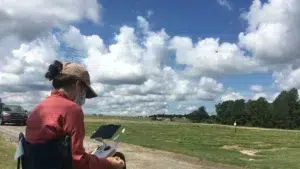Ecologists have long tried to understand and anticipate the compositional change of plant species, especially now, as climate and land usage disrupts the way in which plants colonize and expand their communities. Called plant succession, the study of predicting plant communities through time is one of ecology’s oldest pursuits.
In 2016, Brian Buma, PhD, assistant professor of integrative biology at the University of Colorado Denver, assembled a team of researchers to hunt down and then expand eight long-forgotten, 103-year-old succession plots with a grant from National Geographic. The team discovered the plots and with the new data, revived the longest running succession study in the world.
The researchers found that the initial, random assortment of plants spent a few decades fighting for dominance and sunlight, before settling into a stable and nearly unchanging community for the next 50 years, upending the classic model of thought about succession.
The findings were published in the journal Ecology.
Hunting for quadrats
In 1916, William S. Cooper, an early president of the Ecological Society of America, measured out six one-square meter plots, called quadrats, on the edge of a glacier in Alaska’s remote Glacier Bay National Park to study how an ecosystem develops from scratch. Cooper visited the quadrats every five to 10 years until the 1940s, when it was taken over by his student who maintained the record until his death in 1988. Unfortunately, his student never published the results, and so for over 75 years Cooper’s plots were forgotten and buried in layers of soil and vegetation in the Alaskan bush.
Luckily, the famed ecologist kept a detailed journal of his observations of the life within the small quadrats, along with maps and directions to them, but finding them wouldn’t be easy.
To begin, Cooper’s north isn’t Buma’s north. In the century since Cooper first cataloged the locations of his plots, the Earth’s magnetic pole has shifted about 12 degrees. Other land markings have also changed: a large inlet has since shrunk to a small indentation on the coastline, Cooper’s open fields are now impassable with vegetation, and one of the quadrats became a victim to erosion and fell, quite literally, into the sea.
Cooper drove in steel nails or rebar to mark the corners and piled small rock cairns around them to denote their location. He marked the quadrat locations by pacing out the distance from big boulders, anywhere from 30 to 50 paces, and at varying degrees from North. Notes like “Go 12 paces from the large rock, 27 degrees from north to a small cairn” were common.
Unearthing 75 years of missing data
Armed with laminated photographs of the plots and surrounding areas, Cooper’s original handwritten journals, a metal detector and a bit of luck, researchers spent eight days tracking down the plots, finding the final one within hours of having to leave. Through extensive fieldwork, historical archives, remote sensing and dendrochronological methods, they were able to fill in the data for the missing 75 years.
“Nowhere in the world can you look through data and maps and pictures from one hundred years ago and have the detail required for this type of scientific study,” said Buma.
Upending chronosequence models
Before now, most ecologists have relied on chronosequence studies to study long time periods, in which researchers compare old sites to young sites as representative of the passage of time to study how communities have evolved. But that makes a huge assumption about how those sites differ because the old site may have looked nothing like the young site a hundred years ago, said Buma.
As a result, chronosequence studies have churned out results that predict plants interact with each other over time to form predictable, successional trajectories. Cooper’s Glacier Bay quadrats show the opposite.
Instead of a succession of plants as chronosequence models suggested, the 103-year-old communities remained relatively the same. No other plants came in and the existing plants reproduced asexually.
“It undermines a lot of the normal succession papers because it turns out that space really is important,” said Buma. “There are a lot of random things that happen early in the plot history – where seeds landed, for example – that still influence what we see today. It’s like standing at the edge of a cliff and kicking a rock off of the top. As it falls, the rock may bounce off one way or the other, and you could get hundreds of different paths, even though the rocks started from more or less the same spot.”
In addition to monitoring Cooper’s original quadrats, Buma’s team have expanded the plot sizes, added new baseline biogeochemical data and spatial mapping for future researchers. Their goal is to observe whether or not the conclusions from Cooper’s plot reflects the broader reality now.
“The plots could all end up looking the same in one thousand years,” said Buma. “But right now, in the first one hundred years, we can say that each is very different.”
Source: University Of Colorado Denver












